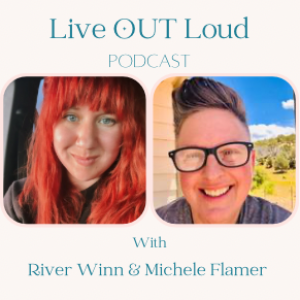
Wednesday Aug 28, 2024
Fear | Samantha Fox
Today Michele has Samantha Fox , the Lesbian Curiosity Coach™ on as her first guest host. Today they discuss Fear. We hope you enjoy and learn through this episode.
Fear can manifest in the body through a variety of physical symptoms, which are part of the body’s natural “fight or flight” response to perceived threats.
Here’s how fear can show up:
1.Increased Heart Rate: When you’re afraid, your heart rate speeds up to pump more blood to your muscles, preparing your body to either fight or flee.
2.Rapid Breathing: Fear can cause you to breathe more quickly as your body tries to take in more oxygen to prepare for physical exertion.
3.Sweating: The body may start to sweat as a way to cool down, preparing for potential physical activity.
4.Tense Muscles: Your muscles may tighten or become tense, readying your body for action. This can lead to feelings of stiffness or soreness, especially if the tension is prolonged.
5.Dilated Pupils: Your pupils may dilate to let in more light, improving your vision and helping you to better assess the situation.
6.Digestive Changes: Fear can slow down or even stop digestion as the body diverts energy away from non-essential functions. This can lead to a “knot in the stomach” feeling, nausea, or even the need to use the restroom.
7.Cold or Clammy Skin: Blood flow may be directed away from the skin’s surface to vital organs, which can make your skin feel cold or clammy.
8.Shaking or Trembling: The adrenaline rush that comes with fear can cause your hands, legs, or even your entire body to shake or tremble.
9.Dry Mouth: The body’s response to fear can inhibit saliva production, leading to a dry mouth.
10.Heightened Senses: Some people may experience heightened senses, such as sharper vision or more acute hearing, as the body becomes more alert to potential dangers.
Fear can be triggered by a wide range of factors, often depending on individual experiences, environments, and even biological predispositions.
Here are some common sources of fear:
1. Threats to Safety
•Physical Danger: Immediate threats to your physical safety, such as a dangerous animal, a car accident, or an intruder, can evoke fear.
•Health Concerns: Fear can arise from illness, injury, or the potential for such events, especially when they are life-threatening.
2. Social and Emotional Threats
•Rejection or Embarrassment: Fear of being rejected, embarrassed, or judged by others can be powerful. This is often linked to social anxiety.
•Failure: The fear of failing, whether in personal or professional endeavors, can stem from the potential loss of respect, opportunities, or self-esteem.
•Loneliness: Fear of being alone or abandoned can be deeply rooted, particularly for those with past experiences of isolation or loss.
3. Uncertainty and the Unknown
•Unpredictable Situations: Facing uncertain or unpredictable situations, such as a new job, moving to a new place, or starting a new relationship, can induce fear.
•Future Events: Worrying about what the future holds, especially when outcomes are unclear, can create fear, even if there is no immediate threat.
4. Past Trauma
•Traumatic Experiences: Past experiences, particularly traumatic ones, can leave a lasting impact, causing fear when similar situations or triggers are encountered.
•Childhood Fears: Fears developed in childhood, such as fear of the dark, strangers, or loud noises, can persist into adulthood or evolve into different fears.
5. Phobias
•Specific Phobias: Some people have intense fears of specific objects or situations, such as heights (acrophobia), spiders (arachnophobia), or enclosed spaces (claustrophobia).
•Social Phobias: Fear of social situations or public speaking can be debilitating for those with social phobia.
No comments yet. Be the first to say something!